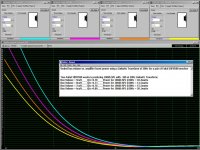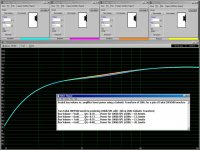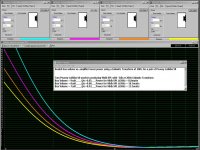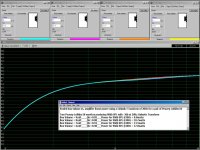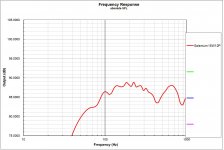You own a very wide range of equipment, and have run a very wide range of experiments. Your LeCleach horn with the JBL 2482 plus a small horn tweeter like the Fostex T90A seems superior to the BMS 4592 coaxial. Because of your interest in sealed woofers, I have attached WinISD data I had on BoostPower vs. BoxVolume that might help your future work. There are positive reviews for sealed box woofer transient response and the lower phase shift. A Linkwitz transform is commonly used to extend the low frequency of a sealed box woofer, and this boost requires extra amplifier power. The size of the sealed box can be changed to better meet the home design goals, but this changes Qtc and boost power as illustrated in the tables. A similar analysis can be run for the woofer of your choice. You could construct your sealed woofers to also mate to a TM top using your Beyma TPL-150H and a midbass.... like the BMF-1 from Tweek Geek.
Two 18" side-side woofers can produce 100db SPL 30Hz bass with just 10 watts of power in an 8cuft cabinet. Two 18" side-side woofers can produce 100db SPL 30Hz bass with just 20 watts of power in a more modest 6cuft cabinet.
=======================================
Sealed box volume vs. amplifier boost power using a Linkwitz Transform of 20Hz for a pair of Faital 18FH500
Two Peavey Faital 18FH500 woofers producing 100db SPL with -3db at 20Hz Linkwitz Transform
Box Volume = 9cuft____Qtc=0.70___Power for 100db SPL @30Hz = 10.4watts
Box Volume = 8cuft____Qtc=0.73___Power for 100db SPL @30Hz = 12.5watts
Box Volume = 7cuft____Qtc=0.76___Power for 100db SPL @30Hz = 15.5watts
Box Volume = 6cuft____Qtc=0.80___Power for 100db SPL @30Hz = 20.18watts
=======================================
Sealed box volume vs. amplifier boost power using a Linkwitz Transform of 20Hz for a pair of Peavey LoRider18
Two Peavey LoRider18 woofers producing 98db SPL with -3db at 20Hz Linkwitz Transform
Box Volume = 9cuft____Qtc=0.85___Power for 98db SPL @30Hz = 8.8watts
Box Volume = 8cuft____Qtc=0.88___Power for 98db SPL @30Hz = 10.7watts
Box Volume = 7cuft____Qtc=0.92___Power for 98db SPL @30Hz = 13.5watts
Box Volume = 6cuft____Qtc=0.98___Power for 98db SPL @30Hz = 17.8watts
Two 18" side-side woofers can produce 100db SPL 30Hz bass with just 10 watts of power in an 8cuft cabinet. Two 18" side-side woofers can produce 100db SPL 30Hz bass with just 20 watts of power in a more modest 6cuft cabinet.
=======================================
Sealed box volume vs. amplifier boost power using a Linkwitz Transform of 20Hz for a pair of Faital 18FH500
Two Peavey Faital 18FH500 woofers producing 100db SPL with -3db at 20Hz Linkwitz Transform
Box Volume = 9cuft____Qtc=0.70___Power for 100db SPL @30Hz = 10.4watts
Box Volume = 8cuft____Qtc=0.73___Power for 100db SPL @30Hz = 12.5watts
Box Volume = 7cuft____Qtc=0.76___Power for 100db SPL @30Hz = 15.5watts
Box Volume = 6cuft____Qtc=0.80___Power for 100db SPL @30Hz = 20.18watts
=======================================
Sealed box volume vs. amplifier boost power using a Linkwitz Transform of 20Hz for a pair of Peavey LoRider18
Two Peavey LoRider18 woofers producing 98db SPL with -3db at 20Hz Linkwitz Transform
Box Volume = 9cuft____Qtc=0.85___Power for 98db SPL @30Hz = 8.8watts
Box Volume = 8cuft____Qtc=0.88___Power for 98db SPL @30Hz = 10.7watts
Box Volume = 7cuft____Qtc=0.92___Power for 98db SPL @30Hz = 13.5watts
Box Volume = 6cuft____Qtc=0.98___Power for 98db SPL @30Hz = 17.8watts
Attachments
Thanks for the further information on the simulations for the 18" drivers. The only worry i have with the counter opposed woofers is that as they are on the sides of the cabinets i won't be able to position the speakers as close to the corners of the room as i would like.
There isn't an arrangement where they can be counter opposing each other, but facing each other, firing into a slot perhaps, so i can have them both transmitting out of the front of the cabinet only?
There isn't an arrangement where they can be counter opposing each other, but facing each other, firing into a slot perhaps, so i can have them both transmitting out of the front of the cabinet only?
ppsl
Why, yes sir. There are a couple of ways. Among the recent, most popular, is known as push-pull, slot load (ppsl). For full 100% reaction-cancelling, use magnet-to-magnet, slot exit (listening to the rear of the cone).
Most will vote for the ppsl as best. (I say, it just depends).
** Please note, the volume of the "plenum" or "slot" adds to the overall cubic volume requirement of the bass enclosure.
**** A thorough forum search should reveal plenty of details on such a design.
Thanks for the further information on the simulations for the 18" drivers. The only worry i have with the counter opposed woofers is that as they are on the sides of the cabinets i won't be able to position the speakers as close to the corners of the room as i would like.
There isn't an arrangement where they can be counter opposing each other, but facing each other, firing into a slot perhaps, so i can have them both transmitting out of the front of the cabinet only?
Why, yes sir. There are a couple of ways. Among the recent, most popular, is known as push-pull, slot load (ppsl). For full 100% reaction-cancelling, use magnet-to-magnet, slot exit (listening to the rear of the cone).
Most will vote for the ppsl as best. (I say, it just depends).
** Please note, the volume of the "plenum" or "slot" adds to the overall cubic volume requirement of the bass enclosure.
**** A thorough forum search should reveal plenty of details on such a design.
The LF response has always been a battle with my room, only recently when changing to the waveguides OB bass has the LF been tamed to some extent. Is having the two bass drivers counterpoise effectively turning then into a dipole? As if it is them my concerns over room placement may be an issue.
andThe LF response has always been a battle with my room, only recently when changing to the waveguides OB bass has the LF been tamed to some extent. Is having the two bass drivers counterpoise effectively turning then into a dipole? As if it is them my concerns over room placement may be an issue.
Sure you're looking in the right direction? If your real problem lies in the loudspeaker-room interface, you could look into multisub approach instead of 18" units. OB is only partly a cure for standing wave problems.The only worry i have with the counter opposed woofers is that as they are on the sides of the cabinets i won't be able to position the speakers as close to the corners of the room as i would like.
350Hz is around the Schroeder frequency. Your lower horn may not be integrating as it isn't accessing the room in a balanced way. Going lower than 40Hz may not be worth it. But obviously you want this horn here to integrate with the mid horn at their crossover.200hz horn crossed at 350hz
<snip>
(40hz with equalisation).
<snip>What I do know is that integrating anything below the midrange horn is more challenging.
With the room dominant below, integration becomes more of how well it couples to the room. An example of which might be something corner loaded (just to illustrate the point). Room influence brings a spatial factor to the response, which can be conjugated by other sources, ala: the multi-sub concept.
If this concerns you you might take the mid a little lower. If you run the mouth around a little further, at this point on the contour it doesn't take much to be worthwhile. In a sense width becomes more significant than earlier in the horn, compared to length. You might be able to postpone group delay a bit.
Depending on what your room frequency is, I find that above this modes can be sketchy. It's worthwhile to have directivity down to this point but it's not always a clear frequency, going lower just makes sure. 200Hz might be a safe bet for the room frequency.
Directivity will widen for the mid horn as you go lower, so if it radiates away from the walls at 350 or even 200, it could widen and you might take it as low as you choose. Rounding back might make various improvements such as smoothness through the band, lower frequency of the delay spike, better LF loading, lower f3, and with the LeCleach holding the edge of a wave long after it exceeds the axial length, running it low ends up with a gradual onset of wall reflections rather than an increase in LF diffraction.
Even if you keep your crossover frequency you'll benefit from some extra mouth, Also at these frequencies GD sensitivity isn't too high so you might be able to cross closer to the cut-off as well.
Of course it's possible you have it good already and it's your listening position/speaker location combination that wants augmenting. Adding woofers for room correction becomes more reliable below the room frequency. The way I see it, if the mid horn happens to widen out to the walls around that frequency you'll set the conditions for the woofer and you'l be using a single source for the mids until the room takes over. The woofer should then be some compromise based on behaving like a corner point source, at least as far as mode energising.
The lower frequency combined with better room dependence should give you more freedom to move the woofers around.
Of course you don't necessarily want to throw 200Hz straight at a side wall as you might do with a direct radiator. A waveguide will emulate a room corner from within the room but bass waveguides are too big. You could open it onto a wall adding a reflection but at these frequencies that may be ok.. just another mode.
If you choose though, another LeCleach horn (and this is why I said earlier you may be good already), can eliminate termination diffraction (but needs a greater roundover, so it depends) and could hold a pattern similar in width to one of the corners (even if it's out from the corner, which may even help a little in delaying reflections), down to some low frequency where it matters even less.. as would group delay, allowing you to take it low.
Adding an extra woofer below 200Hz is a matter of measuring bass from your listening position (RTA would be best as it's steady state). Vary level, phase, low pass point and physical location until your worst peaks and dips clear up. Don't high-pass the main woofers unless you just want to cut the last octave or so. The sub would be mono and the final location should be whatever works.
An actual corner is a good place for a sub if it is intended mainly to cover the lowest octave or two. Other subs might go anywhere and should probably be high-passed above the lowest octave, This octave ndoesn't need to be produced by your main woofers if you go this way.
Directivity will widen for the mid horn as you go lower, so if it radiates away from the walls at 350 or even 200, it could widen and you might take it as low as you choose. Rounding back might make various improvements such as smoothness through the band, lower frequency of the delay spike, better LF loading, lower f3, and with the LeCleach holding the edge of a wave long after it exceeds the axial length, running it low ends up with a gradual onset of wall reflections rather than an increase in LF diffraction.
Even if you keep your crossover frequency you'll benefit from some extra mouth, Also at these frequencies GD sensitivity isn't too high so you might be able to cross closer to the cut-off as well.
Of course it's possible you have it good already and it's your listening position/speaker location combination that wants augmenting. Adding woofers for room correction becomes more reliable below the room frequency. The way I see it, if the mid horn happens to widen out to the walls around that frequency you'll set the conditions for the woofer and you'l be using a single source for the mids until the room takes over. The woofer should then be some compromise based on behaving like a corner point source, at least as far as mode energising.
The lower frequency combined with better room dependence should give you more freedom to move the woofers around.
Of course you don't necessarily want to throw 200Hz straight at a side wall as you might do with a direct radiator. A waveguide will emulate a room corner from within the room but bass waveguides are too big. You could open it onto a wall adding a reflection but at these frequencies that may be ok.. just another mode.
If you choose though, another LeCleach horn (and this is why I said earlier you may be good already), can eliminate termination diffraction (but needs a greater roundover, so it depends) and could hold a pattern similar in width to one of the corners (even if it's out from the corner, which may even help a little in delaying reflections), down to some low frequency where it matters even less.. as would group delay, allowing you to take it low.
Adding an extra woofer below 200Hz is a matter of measuring bass from your listening position (RTA would be best as it's steady state). Vary level, phase, low pass point and physical location until your worst peaks and dips clear up. Don't high-pass the main woofers unless you just want to cut the last octave or so. The sub would be mono and the final location should be whatever works.
An actual corner is a good place for a sub if it is intended mainly to cover the lowest octave or two. Other subs might go anywhere and should probably be high-passed above the lowest octave, This octave ndoesn't need to be produced by your main woofers if you go this way.
Last edited:
In your thread "Horn Loaded Open Baffle Bass" you model the Selenium 15W12p-Nd in Bert's Orelino dipole_rear + horn_front. Your home pictures also show the red Selenium logo in this design. According to the datasheet, the Selenium 15W12p-Nd has an Xmax of 1mm with 10% distortion. Very small for a dipole. The Qts=0.67 is good for a dipole, and the 18mm mechanical limit is good for a dipole, but 10% distortion at just 1mm makes the 15W12p a poor choice for dipole bass.
Have you experimented with any other 15" woofers in your Bert Orelino dipole+horn?
Have you experimented with adding short rear dipole H-frame "wings" to provide a more even front_horn, vs. rear wing loading?
Maybe drop the bass horn loading in your small room:
Linkwitz W-frame (cone-magnet slot, area > 0.5*Sd) cancels motor distortion.
Narrow_Slot-Loaded W-frame (cone-cone slot, area < 0.5*Sd) generates increased dynamics as the frequency decreases.
Have you experimented with any other 15" woofers in your Bert Orelino dipole+horn?
Have you experimented with adding short rear dipole H-frame "wings" to provide a more even front_horn, vs. rear wing loading?
Maybe drop the bass horn loading in your small room:
Linkwitz W-frame (cone-magnet slot, area > 0.5*Sd) cancels motor distortion.
Narrow_Slot-Loaded W-frame (cone-cone slot, area < 0.5*Sd) generates increased dynamics as the frequency decreases.
I am aware that the Selinium drivers have minimal xmax, but they have been used in quite a few OB designs. I got them at a good price and was wanting to experiment with the Orelino concept. I have them front loaded, as i have the rear of the drivers venting through 4" of BAF.
Have considered the H and W frames - the rational for putting the wave guides on the LF section was to get the directionality in the lower mid. They probably are lacking in the bottom octave, and maybe this is where i need the subs positioned around the room to get a smooth response.
I remembered i took some inspiration from the duo mezzo
I quite like the sound these and the uno's give, with the duo having more presence. I never really worked out whether the LF section was horn loaded or just a wave guided sub?
Have considered the H and W frames - the rational for putting the wave guides on the LF section was to get the directionality in the lower mid. They probably are lacking in the bottom octave, and maybe this is where i need the subs positioned around the room to get a smooth response.
I remembered i took some inspiration from the duo mezzo
An externally hosted image should be here but it was not working when we last tested it.
I quite like the sound these and the uno's give, with the duo having more presence. I never really worked out whether the LF section was horn loaded or just a wave guided sub?
Simulation of basic dipole design similar to picture. Maximum SPL from One_15W12P Dipole @10% distortion. Model based upon the pictured baffle and estimated wall distances with one 15W12P speaker at the center. No modeling of BAF rear absorption material.
Attachments
Measure the width. At the least it should be well waveguided where this is a wavelength. The double height (actually four times when you consider the floor image) will add to this but the width will be the weakest link so to speak. Even half a wavelength is having an effect but mouth resonance could also have an effect.I never really worked out whether the LF section was horn loaded or just a wave guided sub?
That sim, isn't far off what i get before equalisation, the BAF loads up the horn as well.
With regard to the DUO Mezzo subwoofer, they claim significantly more LF than the 470cm2 x 21cm long bass horn should be able to generate, its the same sort of mouth area as i have, and the loading decays from 60hz.
Cannot believe that there "Active Dynamic Radiation Impedance Compensation" system extends the LF smoothing it maybe.
With regard to the midrange - the reason for starting this thread, i have "knocked up" some IB boxes for some Altec 414Z's i have i can see the appeal of an IB midrange, but i don't know whether i can live without the dynamics of the horn. I was thinking maybe the next step would be to generate an elliptical horn to match the dispersion angles of the TPL. If i sacrificed the rolled mouth of the Le Cleach maybe i could go a little bit lower.
With regard to the DUO Mezzo subwoofer, they claim significantly more LF than the 470cm2 x 21cm long bass horn should be able to generate, its the same sort of mouth area as i have, and the loading decays from 60hz.
Cannot believe that there "Active Dynamic Radiation Impedance Compensation" system extends the LF smoothing it maybe.
With regard to the midrange - the reason for starting this thread, i have "knocked up" some IB boxes for some Altec 414Z's i have i can see the appeal of an IB midrange, but i don't know whether i can live without the dynamics of the horn. I was thinking maybe the next step would be to generate an elliptical horn to match the dispersion angles of the TPL. If i sacrificed the rolled mouth of the Le Cleach maybe i could go a little bit lower.
This is hard work for not a lot to gain. The narrow direction will need to be longer than the other.an elliptical horn
Double check that in hornresp. I usually find that for a given mouth size/length, the best cut-off frequency for extended bass and lower group delay can be the highest one, meaning a good rollback.If i sacrificed the rolled mouth of the Le Cleach maybe i could go a little bit lower.
Fyi, the SEOS24 can be used down to 380hz with the right driver.300Hz probably isn't a conservative figure.
Hi,
Just thought I would pipe in with the horn that I use. It is the Volti Audio Fs 260, on which I use the BMS 4592nd mid driver. I like it very much, and my listening room is 4 x 6 meters. Greg Roberts is wonderful guy to do business with.
Fc260 Horns - Klipsch Upgrades by Volti Audio
Just thought I would pipe in with the horn that I use. It is the Volti Audio Fs 260, on which I use the BMS 4592nd mid driver. I like it very much, and my listening room is 4 x 6 meters. Greg Roberts is wonderful guy to do business with.
Fc260 Horns - Klipsch Upgrades by Volti Audio
I have the 1.4" inlet, but I believe 1.5" and 2" versions are also available.I don't think they do a 2" version of the SEOS24
- Status
- This old topic is closed. If you want to reopen this topic, contact a moderator using the "Report Post" button.
- Home
- Loudspeakers
- Multi-Way
- Advise on mid range driver
